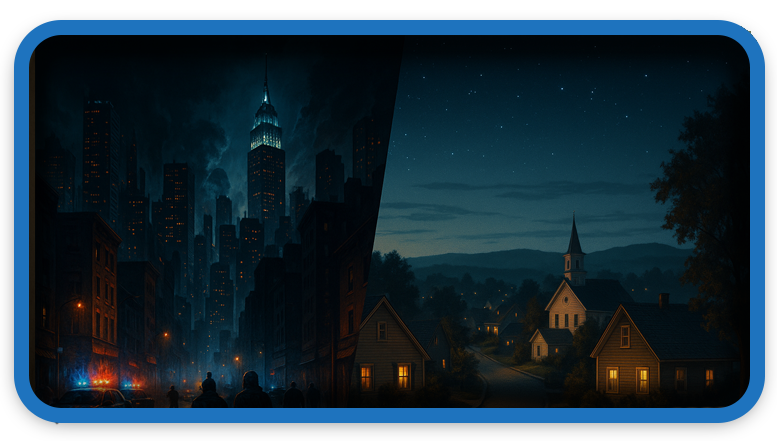⏲️ Estimated reading time: 6 min
Why Big Cities Have Higher Crime Rates Than Small Towns – Extended Analysis. Crime rates differ dramatically between large cities and small towns. While metropolises brim with opportunities and culture, they also harbor higher levels of theft, violence, and organized crime. This article explains why big cities record more crime, supported by global examples, psychology, and sociology.
For centuries, people have debated the safety of cities versus towns. Ancient travelers already knew that venturing into a bustling metropolis like Rome or Constantinople meant facing both incredible opportunities and heightened dangers. Today, the same logic applies: the larger the city, the more crime you are likely to encounter.
But why does this pattern persist across geography, culture, and time? Whether in the Americas, Europe, Asia, or Africa, the reality is consistent: large cities have higher crime rates compared to small towns.
This extended article will explore the issue in depth, looking at sociological, psychological, economic, and cultural factors, alongside comparative studies from multiple countries. We will also address potential solutions and policies for crime reduction in urban environments.
1. Population Density and the Mathematics of Conflict
Large populations naturally create more interactions. More interactions lead to more opportunities for conflict, misunderstanding, theft, and crime.
Example:
- Tokyo, Japan – Despite a low per-capita crime rate, the sheer number of residents (over 37 million in the metropolitan area) means that the total volume of crime cases is significant.
- New York City, USA – With 8.5 million people, even a relatively moderate crime rate per capita translates into thousands of incidents annually.
In smaller towns:
- fewer people → fewer interactions → lower absolute crime numbers.
Mathematically, if 1% of a population is involved in crime, in a town of 10,000 people that equals 100 cases. In a city of 10 million, that equals 100,000 cases.
2. Social and Economic Inequality
Big cities are magnets for wealth but also for poverty. Skyscrapers and luxury boutiques stand side by side with homeless shelters and marginalized communities.
Why inequality fuels crime:
- Visibility of wealth → increases frustration and envy among the people with low-income.
- Limited opportunities → some turn to crime as a survival strategy.
- Class segregation → fosters distrust and hostility.
Case Studies:
- Rio de Janeiro, Brazil – Rich neighborhoods like Leblon exist next to sprawling favelas. Armed robberies and drug trafficking flourish in this environment.
- Johannesburg, South Africa – One of the highest inequality indexes in the world; violent crime is strongly correlated with poverty and wealth contrast.
3. The Anonymity of the Urban Environment
In small towns, everyone knows each other. Social control is immediate: an offender is quickly identified and ostracized.
In big cities:
- anonymity protects criminals,
- neighbors rarely interact,
- transient populations prevent close-knit communities.
This anonymity reduces the psychological barrier to crime. Offenders believe they can “disappear into the crowd.”
4. Strain on Law Enforcement
Big cities usually have larger police forces, yet they remain overwhelmed by the sheer volume of cases.
Problems include:
- slower response times,
- overcrowded prisons,
- corruption in law enforcement,
- “no-go” zones where state authority is weak.
By contrast, small-town police often know residents personally, can respond faster, and exert stronger authority.
5. Migration and Demographic Flux
Metropolises attract:
- migrants seeking jobs,
- seasonal workers,
- international students,
- tourists,
- transient populations.
This demographic flux creates instability:
- strangers are difficult to track,
- communities cannot monitor outsiders,
- organized crime groups exploit vulnerable newcomers.
Example:
- London, UK – a hub for immigrants and tourists; high rates of theft and fraud are linked to transient populations.
- Paris, France – tourism-heavy city where pickpocketing is rampant, especially near monuments like the Eiffel Tower.
6. Crime Opportunities in Urban Environments
Cities are full of potential targets:
- banks, casinos, luxury stores,
- crowded public transport,
- nightclubs, concerts, festivals.
Types of crime specific to cities:
- pickpocketing and purse-snatching in transport,
- organized fraud and cybercrime,
- drug trafficking in nightlife districts,
- armed robberies of high-value targets.

7. Psychological Stress and Aggression
Urban life brings:
- traffic jams,
- noise pollution,
- high competition for jobs,
- chronic stress.
These factors increase aggression and impulsive behavior.
Small towns, by contrast, provide calmer rhythms of life, reducing triggers for violence.
8. Absolute Numbers vs. Per Capita Rates
Important distinction:
- Cities have higher absolute numbers of crimes.
- Small towns sometimes have higher per capita rates, but fewer total cases.
Example:
- A city of 5 million with 2,000 murders = 40 per 100,000.
- A town of 50,000 with 50 murders = 100 per 100,000.
Yet, people perceive big cities as more dangerous because of shocking absolute numbers.
9. Organized Crime in Big Cities
Cartels, mafias, and gangs thrive in cities due to:
- access to ports, airports, and highways,
- corruption of officials,
- large consumer markets for drugs, weapons, and human trafficking.
Examples:
- Mexico City – hub for cartel operations.
- Naples, Italy – home of the Camorra mafia.
- Los Angeles, USA – notorious for gang rivalries.
10. Comparative Case Studies
United States
| City | Population | Crime Rate | Notable Issues |
|---|---|---|---|
| Chicago | 2.7 mil. | High homicide rate | Gang violence |
| New York City | 8.5 mil. | Medium-high | Organized crime, fraud |
| Naperville (IL) | 150k | Very low | Suburban policing efficiency |
Brazil
| City | Population | Crime Rate | Notable Issues |
|---|---|---|---|
| São Paulo | 12 mil. | Medium-high | Robberies, drug gangs |
| Rio de Janeiro | 6.7 mil. | Very high | Favela violence, kidnappings |
| Blumenau | 360k | Much lower | Safer small-scale economy |
Europe
| City | Population | Crime Rate | Notable Issues |
|---|---|---|---|
| Bucharest, Romania | 2 mil. | High thefts | Pickpocketing |
| Paris, France | 11 mil. metro | Medium-high | Tourist scams, theft |
| Bistrița, Romania | 70k | Low | Community policing |
11. Cultural and Historical Influences
Culture shapes crime rates:
- Japan’s emphasis on social harmony → low crime despite huge population.
- USA’s gun culture → higher violent crime.
- Scandinavian welfare systems → reduced inequality and lower crime.
12. Media Influence and Fear Perception
Media plays a role:
- High-profile urban crimes receive heavy coverage.
- Creates perception that big cities are extremely unsafe, even if per capita rates are moderate.
13. Potential Solutions for Safer Cities
- Investment in education and job creation.
- Affordable housing to reduce slums.
- Smart policing: AI surveillance, predictive models.
- Strengthening community programs to reduce anonymity.
- Closing inequality gaps with social policies.
Final Conclusions
The higher crime rates of big cities compared to small towns are the result of multiple intertwined factors: population density, inequality, anonymity, law enforcement strain, migration, stress, and organized crime opportunities.
Cities may appear more dangerous, but they also possess the resources and institutions to reduce crime if they invest wisely. The challenge is achieving a sustainable balance between urban growth and public safety.
🔔 For more tutorials like this, consider subscribing to our blog.
📩 Do you have questions or suggestions? Leave a comment or contact us!
🏷️ Tags: big cities crime, small towns safety, urban vs rural crime, crime statistics, city life, safe cities, causes of crime, crime solutions, urban psychology, social inequality
📢 Hashtags: #crime #bigcities #safety #urbanization #sociology #psychology #urbansafety #crimestatistics #citylife #socialissues
Only logged-in users can submit reports.
Discover more from HelpZone
Subscribe to get the latest posts sent to your email.

